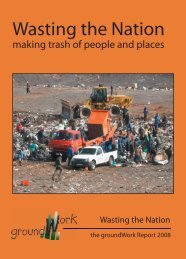Waste Incineration: A Dying Technology - GAIA
Waste Incineration: A Dying Technology - GAIA
Waste Incineration: A Dying Technology - GAIA
Create successful ePaper yourself
Turn your PDF publications into a flip-book with our unique Google optimized e-Paper software.
— which between them comprise 70 percent of the large-scale incinerator market — had been<br />
colluding, in violation of antitrust laws. The FTC recommended that these companies be<br />
excluded from government contracts because of their violations. 96<br />
In the Philippines, corruption in waste projects is seen as endemic, with officials allegedly<br />
receiving up to 40 percent of the value of waste contracts as kickbacks. Since the amount of the<br />
contract is basedupon the quantity of waste to be burned, this undermines waste prevention<br />
and recycling efforts. 97 And in Germany, corruption involving a single incinerator in Cologne is<br />
alleged to have diverted more than US$10 million to individuals and a political party. 98 As with<br />
all corruption issues, hard evidence in most cases is difficult to come by, yet the opportunities<br />
for collusion between non-transparent governments and firms standing to make a large profit<br />
are obvious.<br />
EMPLOYMENT<br />
<strong>Incineration</strong>, by its nature, is a capital-intensive, rather than labor-intensive, approach to<br />
the waste problem. Municipal waste incinerators require an investment of several hundred<br />
million dollars (US) and yet generate only a few dozen jobs, primarily for engineers who are in<br />
much demand elsewhere. Experience has demonstrated the folly of this approach in Northern<br />
countries; in the Southern nations, where capital is harder to come by and labor cheaper, the<br />
situation is even more extreme. In contrast, the alternatives, particularly in the case of health<br />
care waste and municipal waste, are less capital-intensive and generate more jobs. In the United<br />
States, it has been shown that a comprehensive composting, reuse and recycling program<br />
generates ten times as many jobs per ton of municipal waste as do incinerators. 99 In countries<br />
with cheaper labor, this ratio should be even greater.<br />
Job Creation: Reuse & Recycling Versus Disposal in the United States 100<br />
Product Reuse<br />
Type of Operation<br />
Computer Reuse 296<br />
Textile Reclamation 85<br />
Misc. Durables Reuse 62<br />
Wooden Pallet Repair 28<br />
Recycling-Based Manufacturers 25<br />
Paper Mills 18<br />
Glass Product Manufacturers 26<br />
Plastic Product Manufacturers 93<br />
101<br />
Conventional MRFs 10<br />
Composting 4<br />
<strong>Incineration</strong> 1<br />
Landfilling 1<br />
30 <strong>Waste</strong> <strong>Incineration</strong>: A <strong>Dying</strong> <strong>Technology</strong><br />
Jobs Per 10,000<br />
Tons per Year<br />
Incinerators can also displace people from employment. In many Southern countries,<br />
entire populations make a living as resource recoverers, 102 pulling useful and salable items from<br />
household and commercial waste. Called scavengers, ragpickers, waste pickers, catadores or<br />
pepenadores in different societies, they are often found sifting through garbage dumps. Others<br />
collect discarded items house-to-house. Despite being held in low esteem in most societies, they

















